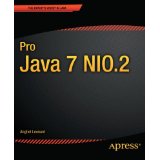Pro Java 7 NIO 2 读书笔记

花了几天把这本书初略的看了一下, 之所以初略的看了一下,是因为这书里确实没啥内容。如果去了NIO 1的内容和大段大段的代码, 基本上压缩到50页应该没问题。
下面简单的罗列一下看到的内容:
Path
这个类在java.nio.file,在NIO里对文件系统进行了进一步的抽象。 是用来替换原来的java.io.File。其中 File
systems.html" target="_blank">Systems, Files, Path, PathMatcher 成为一个体系。
在java7里File和Path可以相互转换: File.toPath(), Path.toFile()
原来的File里包含了文件引用和文件,在Path系统里, Path里是文件的引用,而文件操作都放到了Files的
静态方法里。这种方式究竟好不好用,我没啥感觉。不过我跟人偏向于把操作放到另外一个类里面。
获得Path实例的方式:
class="java" name="code">File.toPath(), Paths.get(), FileSystem.getPath()
注意: Path和File一样,能创建出实例不代表着这个文件一定在文件系统里真是存在。
Path和File相比使用上方便了的地方:
不用特意指定路径的separator:
Paths.get("C:","folder1","subfolder","aa.txt")
在windows系统了是C:\folder1\subfolder\aa.txt
在Mac下是C:/folder/subfolder/aa.txt
Java会根据当前操作系统来决定separator
重复利用基本路径:
//define the fixed path
Path base = Paths.get("C:/rafaelnadal/tournaments/2009");
//resolve BNP.txt file
Path path_1 = base.resolve("BNP.txt");
//output: C:\rafaelnadal\tournaments\2009\BNP.txt
System.out.println(path_1.toString());
//resolve AEGON.txt file
Path path_2 = base.resolve("AEGON.txt");
//output: C:\rafaelnadal\tournaments\2009\AEGON.txt
System.out.println(path_2.toString());
而resolveSibling方法更加好用:可以直接获取相同目录下的其他文件
//define the fixed path
Path base = Paths.get("C:/rafaelnadal/tournaments/2009/BNP.txt");
//resolve sibling AEGON.txt file
Path path = base.resolveSibling("AEGON.txt");
//output: C:\rafaelnadal\tournaments\2009\AEGON.txt
System.out.println(path.toString());
取得相对路径:
假设BNP.txt和AEGON.txt在同一目录下
Path path01 = Paths.get("BNP.txt");
Path path02 = Paths.get("AEGON.txt");
//output: ..\AEGON.txt
Path path01_to_path02 = path01.relativize(path02);
System.out.println(path01_to_path02);
//output: ..\BNP.txt
Path path02_to_path01 = path02.relativize(path01);
System.out.println(path02_to_path01);
假设:
Path path01 = Paths.get("/tournaments/2009/BNP.txt");
Path path02 = Paths.get("/tournaments/2011");
那么:
//output: ..\..\2011
Path path01_to_path02 = path01.relativize(path02);
System.out.println(path01_to_path02);
//output: ..\2009\BNP.txt
Path path02_to_path01 = path02.relativize(path01);
System.out.println(path02_to_path01);
遍历:
Path实现了Iterable<Path>
接口,也就是说我们可以这样:
Path path = Paths.get("C:", "rafaelnadal/tournaments/2009", "BNP.txt");
for (Path name : path) {
System.out.println(name);
}
猜猜结果是什么?
我一开始以为是吧目录下的文件遍历出来呢。结果是这样的:
rafaelnadal
tournaments
2009
BNP.txt
说实话,我觉得这个比较坑爹!
File Attributes
java.nio.file.attribute包下的类提供了
获取文件属性的类,针对不同操作系统使用的类不太一样,当然也有所有操作系统通用的属性。
属性分类有一些几种:
- BasicFileAttributeView
- DosFileAttributeView
- PosixFileAttributeView
- FileOwnerAttributeView
- AclFileAttributeView
- UserDefinedFileAttributeView
获取属性:
BasicFileAttributes attr = null;
Path path = Paths.get("C:/rafaelnadal/tournaments/2009", "BNP.txt");
try {
attr = Files.readAttributes(path, BasicFileAttributes.class);
} catch (IOException e) {
System.err.println(e);
}
System.out.println("File size: " + attr.size());
System.out.println("File creation time: " + attr.creationTime());
System.out.println("File was last accessed at: " + attr.lastAccessTime());
System.out.println("File was last modified at: " + attr.lastModifiedTime());
System.out.println("Is directory? " + attr.isDirectory());
System.out.println("Is regular file? " + attr.isRegularFile());
System.out.println("Is symbolic link? " + attr.isSymbolicLink());
System.out.println("Is other? " + attr.isOther());
或
long size = (Long)Files.getAttribute(path, "basic:size", NOFOLLOW_LINKS);
设置属性:
Path path = Paths.get("C:/rafaelnadal/tournaments/2009", "BNP.txt");
long time = System.currentTimeMillis();
FileTime fileTime = FileTime.fromMillis(time);
try {
Files.getFileAttributeView(path,
BasicFileAttributeView.class).setTimes(fileTime, fileTime, fileTime);
} catch (IOException e) {
System.err.println(e);
}
或
long time = System.currentTimeMillis();
FileTime fileTime = FileTime.fromMillis(time);
try {
Files.setLastModifiedTime(path, fileTime);
} catch (IOException e) {
System.err.println(e);
}
Symbolic和Hard Links
相同于用Java程序实现linux下的 ln命令。
Path link = FileSystems.getDefault().getPath("rafael.nadal.1");
Path target= FileSystems.getDefault().getPath("C:/rafaelnadal/photos", "rafa_winner.jpg");
Files.createSymbolicLink(link, target);
DirectoryStream
这也是一个比较有用的类:用来遍历路径下的子路径或文件,而且支持
通配符过滤。
Path path = Paths.get("C:/rafaelnadal/tournaments/2009");
…
//glob pattern applied
System.out.println("\nGlob pattern applied:");
try (DirectoryStream<Path> ds = Files.newDirectoryStream(path, "*.{png,jpg,bmp}")) {
for (Path file : ds) {
System.out.println(file.getFileName());
}
} catch (IOException e) {
System.err.println(e);
}
FileVisitor和Files.walkFileTree
FileVisitor是一个接口,Files.walkFileTree是一个方法。 通过两者的配合可以遍历整个某个路径下的所有子路径和文件。没有这个之前我们用
递归方法也能实现,有了这个不能说是现实更加容易, 只能说是现实更加规范, 如果大家都用这个,代码的可维护性会更好。我觉得仅此而已。
FileVisitor有四个方法
FileVisitResult postVisitDirectory(T dir, IOException exc)
Invoked for a directory after entries in the directory, and all of their descendants, have been visited.
FileVisitResult preVisitDirectory(T dir, BasicFileAttributes attrs)
Invoked for a directory before entries in the directory are visited.
FileVisitResult visitFile(T file, BasicFileAttributes attrs)
Invoked for a file in a directory.
FileVisitResult visitFileFailed(T file, IOException exc)
Invoked for a file that could not be visited.
FileVisitResult
枚举类型:
CONTINUE,SKIP_SIBLINGS,SKIP_SUBTREE,TERMINATE
Watch Service API
这是NIO2里比较重要的一个新增功能, 以前直接用java监视文件系统的变化是不可能的,只能通过jni的方式调用操作系统的api来对文件系统进行监视。在java7里这部分被加到了标准库里,这样我们就不能在去寻找jni的结果方案了。但是事实上为了保持java的扩平台特性,监控的功能范围被定为各个操作系统的交集,所以没有特殊的情况还是需要直接调用操作系统的api来实现。
public void watchRNDir(Path path) throws IOException, InterruptedException {
try (WatchService watchService = FileSystems.getDefault().newWatchService()) {
path.register(watchService, StandardWatchEventKinds.ENTRY_CREATE,
StandardWatchEventKinds.ENTRY_MODIFY, StandardWatchEventKinds.ENTRY_DELETE);
//start an infinite loop
while (true) {
//retrieve and remove the next watch key
final WatchKey key = watchService.take();
//get list of pending events for the watch key
for (WatchEvent<?> watchEvent : key.pollEvents()) {
//get the kind of event (create, modify, delete)
final Kind<?> kind = watchEvent.kind();
//handle OVERFLOW event
if (kind == StandardWatchEventKinds.OVERFLOW) {
continue;
}
//get the filename for the event
final WatchEvent<Path> watchEventPath = (WatchEvent<Path>) watchEvent;
final Path filename = watchEventPath.context();
//print it out
System.out.println(kind + " -> " + filename);
}
//reset the key
boolean valid = key.reset();
//exit loop if the key is not valid (if the directory was deleted, for example)
if (!valid) {
break;
}
}
}
}
Random Access Files
主要是提供了一个SeekableByteChannel接口,配合ByteBuffer使随机访问文件更加方便。
Path path = Paths.get("C:/rafaelnadal/tournaments/2009", "MovistarOpen.txt");
ByteBuffer buffer = ByteBuffer.allocate(1);
String encoding = System.getProperty("file.encoding");
try (SeekableByteChannel seekableByteChannel = (Files.newByteChannel(path, EnumSet.of(StandardOpenOption.READ)))) {
//the initial position should be 0 anyway
seekableByteChannel.position(0);
System.out.println("Reading one character from position: " + seekableByteChannel.position());
seekableByteChannel.read(buffer);
buffer.flip();
System.out.print(Charset.forName(encoding).decode(buffer));
buffer.rewind();
//get into the middle
seekableByteChannel.position(seekableByteChannel.size()/2);
System.out.println("\nReading one character from position: " + seekableByteChannel.position());
seekableByteChannel.read(buffer);
buffer.flip();
System.out.print(Charset.forName(encoding).decode(buffer));
buffer.rewind();
//get to the end
seekableByteChannel.position(seekableByteChannel.size()-1);
System.out.println("\nReading one character from position: " + seekableByteChannel.position());
seekableByteChannel.read(buffer);
buffer.flip();
System.out.print(Charset.forName(encoding).decode(buffer));
buffer.clear();
} catch (IOException ex) {
System.err.println(ex);
}
Asynchronous Channel API
这个是NIO2的较大的变化,有原来的Selecor方法变成方法回调模式。使用上更加方便。并且文件的读写也可以
异步的方式实现了。
异步读取文件:
ByteBuffer buffer = ByteBuffer.allocate(100);
Path path = Paths.get("C:/rafaelnadal/grandslam/RolandGarros", "story.txt");
try (AsynchronousFileChannel asynchronousFileChannel = AsynchronousFileChannel.open(path, StandardOpenOption.READ)) {
current = Thread.currentThread();
asynchronousFileChannel.read(buffer, 0, "Read operation status ...", new CompletionHandler<Integer, Object>() {
@Override
public void completed(Integer result, Object attachment) {
System.out.println(attachment);
System.out.print("Read bytes: " + result);
current.interrupt();
}
@Override
public void failed(Throwable exc, Object attachment) {
System.out.println(attachment);
System.out.println("Error:" + exc);
current.interrupt();
}
});
System.out.println("\nWaiting for reading operation to end ...\n");
try {
current.join();
} catch (InterruptedException e) {
}
//now the buffer contains the read bytes
System.out.println("\n\nClose everything and leave! Bye, bye ...");
} catch (Exception ex) {
System.err.println(ex);
}
异步socket服务器
public class AsyncEchoServer {
private AsynchronousServerSocketChannel serverChannel;
public void start() throws IOException {
System.out.println(String.format("start: name: %s", Thread.currentThread().getName()));
serverChannel = AsynchronousServerSocketChannel.open();
serverChannel.setOption(StandardSocketOptions.SO_REUSEADDR, true);
serverChannel.bind(new InetSocketAddress(8000));
serverChannel.accept(serverChannel, new Acceptor());
}
class Acceptor implements CompletionHandler<AsynchronousSocketChannel, AsynchronousServerSocketChannel> {
private final ByteBuffer buffer = ByteBuffer.allocate(1024);
public Acceptor(){
System.out.println("an acceptor has created.");
}
public void completed(final AsynchronousSocketChannel channel, AsynchronousServerSocketChannel serverChannel) {
System.out.println(String.format("write: name: %s", Thread.currentThread().getName()));
channel.read(buffer, channel, new Reader(buffer));
serverChannel.accept(serverChannel, new Acceptor());
}
public void failed(Throwable exception, AsynchronousServerSocketChannel serverChannel) {
throw new RuntimeException(exception);
}
}
class Reader implements CompletionHandler<Integer, AsynchronousSocketChannel> {
private ByteBuffer buffer;
public Reader(ByteBuffer buffer){
this.buffer = buffer;
}
public void completed(Integer result, AsynchronousSocketChannel channel){
System.out.println(String.format("read: name: %s", Thread.currentThread().getName()));
if(result != null && result < 0){
try{
channel.close();
return;
}catch(IOException ignore){}
}
buffer.flip();
channel.write(buffer, channel, new Writer(buffer));
}
public void failed(Throwable exception, AsynchronousSocketChannel channel){
throw new RuntimeException(exception);
}
}
class Writer implements CompletionHandler<Integer, AsynchronousSocketChannel> {
private ByteBuffer buffer;
public Writer(ByteBuffer buffer){
this.buffer = buffer;
}
public void completed(Integer result, AsynchronousSocketChannel channel) {
System.out.println(String.format("write: name: %s", Thread.currentThread().getName()));
buffer.clear();
channel.read(buffer, channel, new Reader(buffer));
}
public void failed(Throwable exception, AsynchronousSocketChannel channel) {
throw new RuntimeException(exception);
}
}
public static void main(String[] args) throws IOException, InterruptedException{
new AsyncEchoServer().start();
while(true){
Thread.sleep(1000L);
}
}
}

- 大小: 4.7 KB
